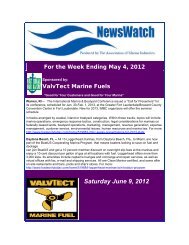By Charles FortTechnical AdviceFrom Bob AdrianceEthanol And Older EnginesOver the past few years — since ethanol has become commonfor boat engines — Seaworthy has received hundreds<strong>of</strong> calls and e-mails complaining about problems that ethanolhas created for their engines. The majority <strong>of</strong> theseinquiries have one thing in common: They concern olderengines, those made before around 1990, and a high percentage<strong>of</strong> them involve outboard engines. What is it aboutolder boats that make them more susceptible to ethanol’swell-known problems? Seaworthy talked to Ed Alyanak,Mercury Marine’s manager <strong>of</strong> engine test and planningdevelopment, and Frank Kelley, Mercury’s fuels and lubricantstechnical specialist — who between them have over60 years <strong>of</strong> experience — to find out why older engines suffermore than newer ones and what owners <strong>of</strong> these enginescan do to minimize the problems.Boat engines comprise one <strong>of</strong> the largest segments <strong>of</strong> “legacy”engines in the country. Unlike cars, boats <strong>of</strong>ten operatefor decades, which means that there are hundreds <strong>of</strong> thousands<strong>of</strong> older engines — many <strong>of</strong> which were built 20, 30,or more years ago — still churning the water. According toAlyanak, these engines were engineered and built withoutthe knowledge that they would be vulnerable to new fuelsin the future. “No one knew ethanol would be a commonadditive to gasoline 20 or 30 years ago. We designed enginesto run on straight gas,” he says. And it’s not just theengines that are affected by ethanol. Alyanak says that hundreds<strong>of</strong> boatbuilders who designed the engines’ fuel systemsfrom the gas tank to the engine were also unaware <strong>of</strong>the future challenges from ethanol. And the very simplicity<strong>of</strong> older carbureted outboard engines seems to make themparticularly susceptible.The issues for older engines fit into three categories: oldvulnerable components not designed for ethanol use, ethanol’sability to dissolve deposits, and its ability to absorbenough water to separate.New StandardsIn the mid-1980s, a committee made up <strong>of</strong> people fromthe U.S. Coast Guard, the Society <strong>of</strong> American Engineers(SAE), the American Boat and Yacht Council (ABYC), the12National Fire Protection Agency (NFPA), and UnderwritersLaboratories (UL) got together. E10 (known as gasoholback then) was being introduced for automobile use and itquickly became evident that it would find its way to boats.New standards for hoses were necessary since ethanol wasknown to attack rubber and plastics. The result was a standardcalled SAE J1527. Since 1984, all hoses approved formarine use in gas engines have had to be built to this standardand hoses marked “SAE J1527” are capable <strong>of</strong> withstandingethanol blends. Hoses not J1527-compliant willquickly deteriorate, potentially causing dangerous leaks,and should be replaced immediately. Something else toconsider: Fuel hoses don’t last forever and those from the80s — even if they are properly marked — should be replaced.Most manufacturers advise replacing gasoline fuelhose after 10 years, and any hose that is 20 years old is waypast its life; all marine-grade fuel hose has its manufacturedate stamped on it.Plastic and Aluminum ProblemsFrank Kelley, Mercury’s fuel specialist, says that other plasticand rubber parts on older engines are susceptible toethanol as well. These include seals and O-rings in the fuelsystem and carburetors. “Rubber materials tend to get hardand brittle with exposure, which can cause problems withneedle valves in carburetors,” he says. Some <strong>of</strong> these rubbercomponents can be partially dissolved with constant exposureto ethanol, and bits and pieces can be carried into theengine’s fuel system, causing clogs and misfires. Some olderboats may still have plastic fuel filter bowls, which willdegrade with exposure to ethanol and could leak, spillingTechnical Advice Continued on Page 13
Technical Advice Continued from Page 12gasoline into the bilge (old plastic fuel filter bowls shouldbe replaced immediately with metal ones).One other troublesome area, according to Alyanak, is aluminumcarburetors. Before about 1990, carburetors werebuilt with alloys that were much more subject to corrosionfrom ethanol. When ethanol contacts the older aluminumcarburetor housings, corrosion can cause tiny orifices toclog, which results in hard starting and poor running, two<strong>of</strong> the most common complaints, especially from outboardowners. This is one <strong>of</strong> the most serious problems for olderoutboards because there is <strong>of</strong>ten no upgraded carburetorthat can be fitted. The only effective solution is to run ethanol-freegasoline (see sidebar). Alyanak says that manufacturersnow use new alloys that are far more corrosionresistant.Non-engine-related problem spots on older boats are thefuel-fill gasket, which with age and ethanol exposure canallow rainwater and spray into the fuel tank (more on thatlater), and fiberglass gas tanks. Not many boats have fiberglasstanks, which have been shown to leach out chemicalsthat eventually gum up intake valves and wreck engines.The leaching process also severely weakens the tanks,which in some cases can cause gasoline leaks in the bilge.The only sure cure is to replace the tank with an aluminumone.SolventAnother one <strong>of</strong> ethanol’s properties that causes headachesfor older boats is its solvent ability. According to Kelley,over the years, gasoline — especially gasoline that may bemore than one season old — oxidizes and creates gums andsludge, which coat the inside <strong>of</strong> fuel tanks and even hoses.When gas containing ethanol is introduced, it begins todissolve the gunk, which is carried to the fuel filter. Initially,this is more <strong>of</strong> a nuisance since simply changing thefilters a few times usually solves the problem. But anythingthat gets past the filter, or is already downstream <strong>of</strong> the filter,can cause havoc in the carburetor. Carburetors havetiny orifices that get easily clogged, leading to hard starting,rough running, or even a complete shutdown. Simplygetting the carburetor cleaned or rebuilt is <strong>of</strong>ten just ashort-term solution; preventing the gunk from getting tothe carb again is critical. A finer-grade filter (10 microns)will prevent most particles from getting to the carb, thoughthe filters may clog up more frequently as the ethanol dissolvesthe gunk. (Carry spares and a galvanized bucket tokeep old filters prior to disposal.) Any hoses that lead fromthe filter to the carburetor should also be replaced since13they may have deposits inside them that get washed intothe carburetor by ethanol.Ethanol Loves WaterFinding Non-Ethanol GasThe best way to eliminate the worry about the effects<strong>of</strong> ethanol on an older engine is simple: Don’t usegas containing ethanol. Fortunately, that has becomeeasier lately, with many marinas now stocking E0,and websites showing where it’s available. There iseven an iPhone app for that (itunes.apple.com/us/app/pure-gas/id454559068?ls=1&mt=8). Below aretwo sites that list non-ethanol gas — most are autogas stations (available for trailer boaters), thoughmany marinas are listed, too.• www.pure-gas.org/index.jsp• www.buyrealgas.comBefore you fuel up at one <strong>of</strong> these places, you shouldknow a few things though. Gas composition tendsto change quickly and the availability <strong>of</strong> E0 is dependenton whether or not it’s available from local distributors,so be sure and ask the station if the fuel isstill ethanol-free. Also, pump labels are not very reliable.Even though the pump states that gas contains10-percent ethanol, it could be any number belowthat as well; it’s just not legal for it to be more.In some states, marinas are exempt from listingethanol content, so just because there’s no label, thatdoesn’t mean there’s there is no ethanol — ask theoperator. In some areas, E0 may be considered a“boutique fuel” and cost more than E10. Finally, ifyou want to know exactly how much ethanol thereis in gas, you can test it yourself. Simple reusable kitsare available online that will accurately find the ethanolcontent (www.fuel-testers.com).Ethanol is hygroscopic, which means it readily absorbs water.This is good news, and bad; According to Kelley, thegood news is that small amounts <strong>of</strong> water in gasoline areabsorbed and simply get burned along with the fuel. Thebad news is that gas with ethanol will keep absorbing wateruntil there is so much that most <strong>of</strong> the ethanol and waterwill separate and sink to the bottom <strong>of</strong> the tank. This iscalled phase separation. The process is more common inTechnical Advice Continued on Page 14












